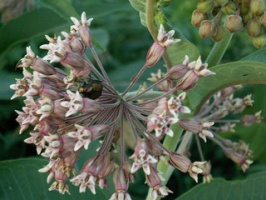
Japanese beetle eating a butterfly weed by rosefirerising
Japanese beetles are herbivores, so they eat only plants and not animals. They’re most notorious for eating rosebuds and other flowers, but Japanese beetles consume a wide range of vegetation.
Japanese beetles tend to swarm when feeding, and a colony can quickly descend and congregate on trees and other plants. They are attracted by the pheromones given off by damaged leaves, so a weakened tree becomes an even greater target for Japanese beetle attack.
Japanese beetles don’t eat the entire plant, they consume only the leaves and buds but not the stem or trunk of the plant. Often only the veiny structure of the leaves is left behind after the fleshy part of the leaf has been devoured.
A plant that has been targeted by Japanese beetles will likely have holes eaten through its leaves and buds. This makes it difficult for the plant to create energy through photosynthesis because it’s leaves are vital to that process. Japanese beetles can easily kill trees and flowers by eating their leaves.
Here’s a sample list of the types of plants that Japanese beetles like to eat: basil, birch trees, cherry trees, clematis, corn, cucumbers, ferns, geraniums, grapes, grass, hostas, hydrangea, impatiens, lilacs, linden trees, maple trees, marigolds, petunas, phlox, raspberries, spirea, strawberries, tomatoes, and viburnum.
Take steps to protect your plants from Japanese beetles to prevent this leaf damage.
What do Japanese beetle grubs eat?
Most people don’t realize that nine months out of the year Japanese beetles spend their lives as grubs living underground. During this time they are constantly feeding on the roots of plants and other organic material in the soil. The beetle grubs have a voracious appetite and eat a great amount of food in relation to their size.

Leave a Comment